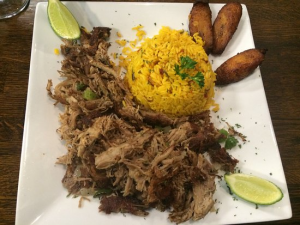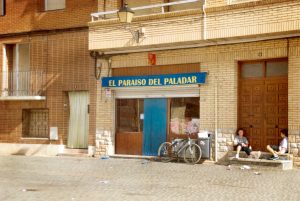Cuba’s Culinary History and Future
By Nora_Stone • December 13, 2018

Between 1990 and 1995, the average Cuban lost 8 to 11 pounds (Franco). The dream of a tropical Communist utopia came to a screeching halt. Cubans were hungry. Food was scarce. People, allegedly, resorted to eating cats (Wilson 83). These years were dubbed the Special Period. The Special Period followed the collapse of the Soviet Union. Thus, the collapse of Soviet petroleum imports in Cuba. No petroleum, no fuel for tractors. No tractors, no harvesting crops. Which meant no dishes like yuca con mojo (yuca seasoned with olive oil, garlic and salt). The agriculture of Cuba crumbled. Cubans were forced to adapt. Many of Cuba’s most beloved dishes are connected to political, economic, and social strife throughout its history. Today’s Cuban cuisine is a result of Spanish colonization, sugarcane plantations, and modern day tourism.
This is the reality of food rationing in Cuba: “five eggs per month, one piece of bread per day, and one chicken leg every 45 days” (Driver). Since the 60s, Cubans have lived off ration books or libreta de abastecimiento (Carter). It is a failsafe that keeps Cubans from starving, but it does not keep them from being hungry (Figure 2). What is or is not rationed depends on supply, and with 80% of food being imported, Cubans only get the basics (rice, beans, coffee, eggs, cooking oil, ect.). Everything else? That has to be purchased at the government-owned and subsidized markets. But with an average monthly salary of $20, most Cubans aren’t splurging on truffle oil or Kobe beef (Carter). Not surprisingly, the precarious food situation in Cuba is not conducive to the opulence or indulgence that might be found in French or Italian cooking. Instead, Cuban cuisine relies on simple ingredients that are packed with flavor. Most dishes are an arrangement of meats and starches. Almost any Cuban meal will have one or more of the following: beans, rice, plantains, yucca, pork, chicken and beef.

The flavor influences of Cuba developed long before communism. In 1492, Christopher Columbus landed on an island smaller than England. He decided to name it Isla Juana or, as it its known today, Cuba (Andrea). The Spanish colonization had an enormous impact. Its presence still lingers in the architecture of Havana, the Spanish language, and the food. One dish that best embodies Spain’s influence is Moros y Cristianos (Figure 4). The name in English means “Moors and Christians.” This is the Cuban spin on rice and black beans. The dish is symbolic for the Reconquista. This event was a series of battles between the Spanish Christians and the Muslim Moors on the Iberian Peninsula. The black beans represent the Moors while the white rice is the Spanish. It became a Cuban dish when Spaniards with plantations remained in the country and shared their food traditions. Now, Moros y Cristianos is not just some black beans and rice thrown on a plate. The two are simmered together in a sauté of cumin, garlic, salt, and oregano. As a result, the rice takes on some of the bean’s dark color. Once complete it is a savory, garlicky mix of fluffy rice and soft beans.

The foods grown in Cuba are important for cooking as well as contextualized its past. Cuba’s agricultural history begins and (to some extent) ends with sugarcane. It is a dark history. In the beginning, the Spanish colonist established plantations and forced enslaved Africans to work the fields. Hence, why about 35% of the population identified as having African ancestry in 2012 (The World Factbook). Until the Special Period, Cuba operated on a successful monocrop industry of sugarcane. But when the economy tanked, 71 of the 156 sugar refineries closed (Atwood). Sugarcane is still one of Cuba’s largest exports. It is also the main ingredient in Cuban rum, another important facet of the country’s culture. It is the staple to the mojito; the iconic highball that is best served with Cuban rum. The refreshing citrus and mint mixture is ideal for beating the tropical heat and is a favorite with tourists.

Nothing draws in tourism quite like boutique hotels, fine dining, cruise ships. You name it; it’s there. Since Americans can now visit Cuba, tourism in Havana is increasingly popular. But no matter how many building are refurbished or food tours reinvigorate the city, life does not really change for the locals. Most Habaneros (Havana natives) could not afford dinner at the restaurants frequented by tourists (Driver). These establishments are owned by the government with the intent of drawing in more money from tourists and elite Cubans (“Cuba”). However, there is the rare occasion where a citizen can own (partially) and operate their own restaurant or paladar (Figure 1). In Anthony Bourdain: No Reservations’s “Cuba” episode, Bourdain eats at Los Amigos. The paladar is owned by Elizabeth Espinoza. She runs it out of her home with her family. Some of her dishes are tamales filled with pork, garlic, and red peppers, Lechon Asado con Mojo which is tender pork marinated in garlic sauce for three hours and grilled for a crispy outer layer (Figure 3). Nonetheless, the menu is subject to whatever is available to Espinoza in the markets. This makes consistency a challenge for paladares trying to feed Cubans and tourists alike.
The obstacles that Cubans have been forced to overcome have never broken their spirits or bruised their pride in their country. If anything, the struggles have strengthened the Cuban identity and instilled a greater appreciation for the cuisine and culture. The hope is that Cubans will find agricultural sustainability whether through technological advancement or economic growth. This independence will decrease reliance on imports, support restaurant tourism, and put more food on Cuban tables so that Cuban foodways continue to thrive.
Sources
Andrea, Alfred J.; Overfield, James H. (2005). “Letter by Christopher Columbus concerning recently discovered islands”. The Human Record. 1. Houghton Mifflin Company. p. 8. ISBN978-0-618-37040-5.
Carter, Andrea. “Cuba’s Food-Rationing Systems and Alternatives.” Cornell University, 2013, https://www.coralgablescavaliers.org/ourpages/users/099346/IB%20History/Americas/Cuba/Cuba_s%20Food%20Rationing.pdf. Accessed 18 Sept. 2018.
“Cuba.” Anthony Bourdain: No Reservations, written by Anthony Bourdain, directed by Hal Leigh, Zero Point Zero Production Inc., 2011.
Driver, Alice. “Stale Bread with Ham and Rum: Tourism in the Time of Cuba.” MUNCHINES (Vice), 25 Aug. 2016, https://munchies.vice.com/en_us/article/jpkvg4/stale-bread-with-ham-and-rum-tourism-in-the-time-of-cuba. Accessed 18 Sept. 2018.
Franco, Manuel et al. “Obesity Reduction and Its Possible Consequences: What Can We Learn from Cuba’s Special Period?” CMAJ : Canadian Medical Association Journal 178.8 (2008): 1032–1034. PMC. Web. 17 Sept. 2018.
The World Factbook: Cuba. Central Intelligence Agency, 2018, https://www.cia.gov/library/publications/the-world-factbook/geos/cu.html. Accessed 19 Sept. 2018.
Wilson, Suzanne Leigh. When Disorder is the Order: Cuba during the Special Period. 2011. U of California, Berkeley, PhD dissertation. http://digitalassets.lib.berkeley.edu/etd/ucb/text/Wilson_berkeley_0028E_11649.pdf